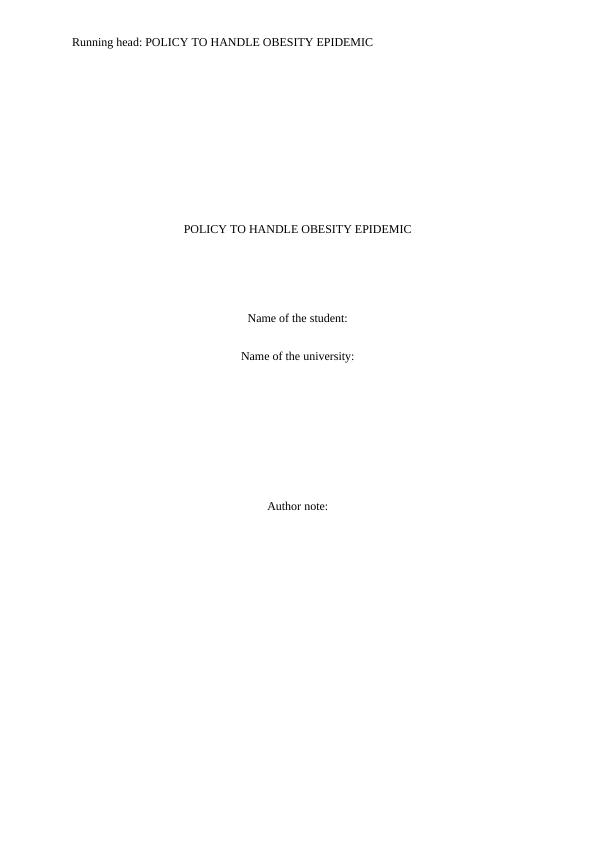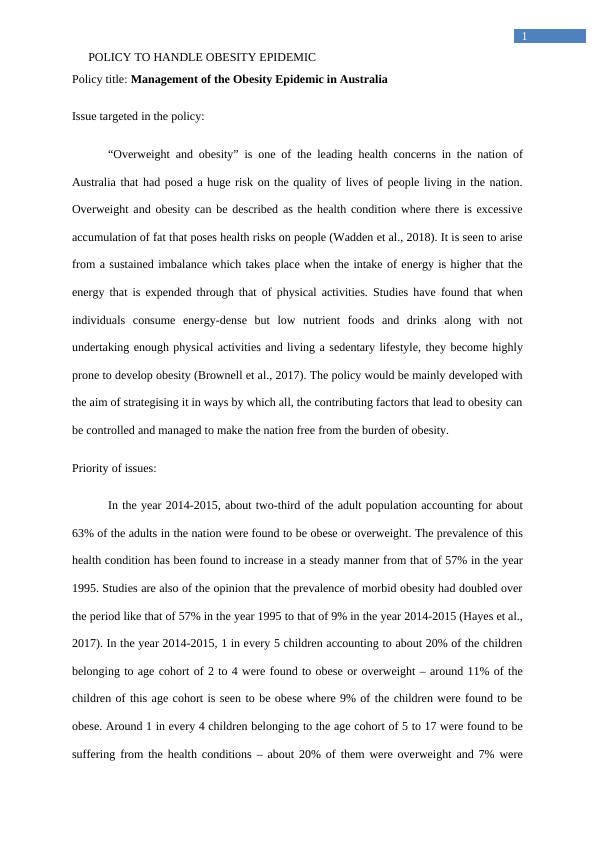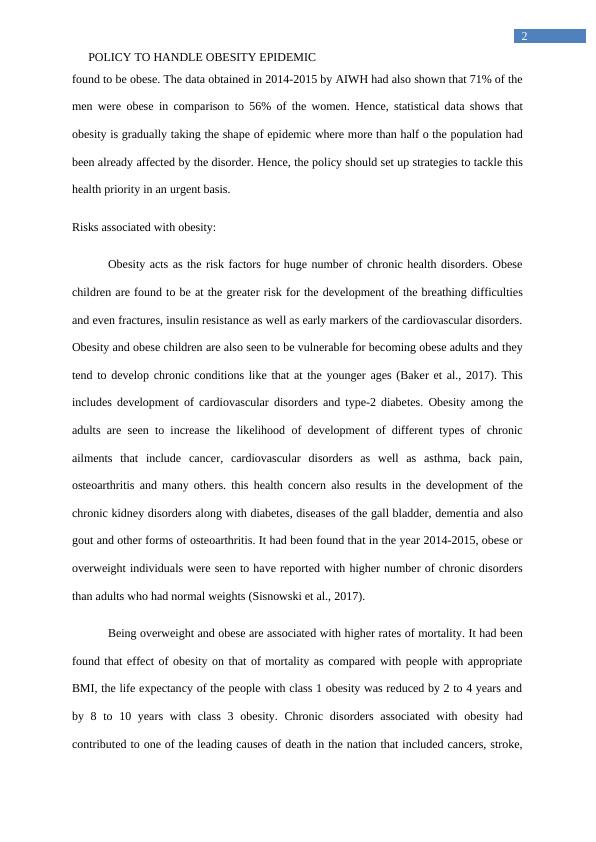Policy to Handle Obesity Epidemic
Added on 2023-01-16
13 Pages3931 Words85 Views
Running head: POLICY TO HANDLE OBESITY EPIDEMIC
POLICY TO HANDLE OBESITY EPIDEMIC
Name of the student:
Name of the university:
Author note:
POLICY TO HANDLE OBESITY EPIDEMIC
Name of the student:
Name of the university:
Author note:

1
POLICY TO HANDLE OBESITY EPIDEMIC
Policy title: Management of the Obesity Epidemic in Australia
Issue targeted in the policy:
“Overweight and obesity” is one of the leading health concerns in the nation of
Australia that had posed a huge risk on the quality of lives of people living in the nation.
Overweight and obesity can be described as the health condition where there is excessive
accumulation of fat that poses health risks on people (Wadden et al., 2018). It is seen to arise
from a sustained imbalance which takes place when the intake of energy is higher that the
energy that is expended through that of physical activities. Studies have found that when
individuals consume energy-dense but low nutrient foods and drinks along with not
undertaking enough physical activities and living a sedentary lifestyle, they become highly
prone to develop obesity (Brownell et al., 2017). The policy would be mainly developed with
the aim of strategising it in ways by which all, the contributing factors that lead to obesity can
be controlled and managed to make the nation free from the burden of obesity.
Priority of issues:
In the year 2014-2015, about two-third of the adult population accounting for about
63% of the adults in the nation were found to be obese or overweight. The prevalence of this
health condition has been found to increase in a steady manner from that of 57% in the year
1995. Studies are also of the opinion that the prevalence of morbid obesity had doubled over
the period like that of 57% in the year 1995 to that of 9% in the year 2014-2015 (Hayes et al.,
2017). In the year 2014-2015, 1 in every 5 children accounting to about 20% of the children
belonging to age cohort of 2 to 4 were found to obese or overweight – around 11% of the
children of this age cohort is seen to be obese where 9% of the children were found to be
obese. Around 1 in every 4 children belonging to the age cohort of 5 to 17 were found to be
suffering from the health conditions – about 20% of them were overweight and 7% were
POLICY TO HANDLE OBESITY EPIDEMIC
Policy title: Management of the Obesity Epidemic in Australia
Issue targeted in the policy:
“Overweight and obesity” is one of the leading health concerns in the nation of
Australia that had posed a huge risk on the quality of lives of people living in the nation.
Overweight and obesity can be described as the health condition where there is excessive
accumulation of fat that poses health risks on people (Wadden et al., 2018). It is seen to arise
from a sustained imbalance which takes place when the intake of energy is higher that the
energy that is expended through that of physical activities. Studies have found that when
individuals consume energy-dense but low nutrient foods and drinks along with not
undertaking enough physical activities and living a sedentary lifestyle, they become highly
prone to develop obesity (Brownell et al., 2017). The policy would be mainly developed with
the aim of strategising it in ways by which all, the contributing factors that lead to obesity can
be controlled and managed to make the nation free from the burden of obesity.
Priority of issues:
In the year 2014-2015, about two-third of the adult population accounting for about
63% of the adults in the nation were found to be obese or overweight. The prevalence of this
health condition has been found to increase in a steady manner from that of 57% in the year
1995. Studies are also of the opinion that the prevalence of morbid obesity had doubled over
the period like that of 57% in the year 1995 to that of 9% in the year 2014-2015 (Hayes et al.,
2017). In the year 2014-2015, 1 in every 5 children accounting to about 20% of the children
belonging to age cohort of 2 to 4 were found to obese or overweight – around 11% of the
children of this age cohort is seen to be obese where 9% of the children were found to be
obese. Around 1 in every 4 children belonging to the age cohort of 5 to 17 were found to be
suffering from the health conditions – about 20% of them were overweight and 7% were

2
POLICY TO HANDLE OBESITY EPIDEMIC
found to be obese. The data obtained in 2014-2015 by AIWH had also shown that 71% of the
men were obese in comparison to 56% of the women. Hence, statistical data shows that
obesity is gradually taking the shape of epidemic where more than half o the population had
been already affected by the disorder. Hence, the policy should set up strategies to tackle this
health priority in an urgent basis.
Risks associated with obesity:
Obesity acts as the risk factors for huge number of chronic health disorders. Obese
children are found to be at the greater risk for the development of the breathing difficulties
and even fractures, insulin resistance as well as early markers of the cardiovascular disorders.
Obesity and obese children are also seen to be vulnerable for becoming obese adults and they
tend to develop chronic conditions like that at the younger ages (Baker et al., 2017). This
includes development of cardiovascular disorders and type-2 diabetes. Obesity among the
adults are seen to increase the likelihood of development of different types of chronic
ailments that include cancer, cardiovascular disorders as well as asthma, back pain,
osteoarthritis and many others. this health concern also results in the development of the
chronic kidney disorders along with diabetes, diseases of the gall bladder, dementia and also
gout and other forms of osteoarthritis. It had been found that in the year 2014-2015, obese or
overweight individuals were seen to have reported with higher number of chronic disorders
than adults who had normal weights (Sisnowski et al., 2017).
Being overweight and obese are associated with higher rates of mortality. It had been
found that effect of obesity on that of mortality as compared with people with appropriate
BMI, the life expectancy of the people with class 1 obesity was reduced by 2 to 4 years and
by 8 to 10 years with class 3 obesity. Chronic disorders associated with obesity had
contributed to one of the leading causes of death in the nation that included cancers, stroke,
POLICY TO HANDLE OBESITY EPIDEMIC
found to be obese. The data obtained in 2014-2015 by AIWH had also shown that 71% of the
men were obese in comparison to 56% of the women. Hence, statistical data shows that
obesity is gradually taking the shape of epidemic where more than half o the population had
been already affected by the disorder. Hence, the policy should set up strategies to tackle this
health priority in an urgent basis.
Risks associated with obesity:
Obesity acts as the risk factors for huge number of chronic health disorders. Obese
children are found to be at the greater risk for the development of the breathing difficulties
and even fractures, insulin resistance as well as early markers of the cardiovascular disorders.
Obesity and obese children are also seen to be vulnerable for becoming obese adults and they
tend to develop chronic conditions like that at the younger ages (Baker et al., 2017). This
includes development of cardiovascular disorders and type-2 diabetes. Obesity among the
adults are seen to increase the likelihood of development of different types of chronic
ailments that include cancer, cardiovascular disorders as well as asthma, back pain,
osteoarthritis and many others. this health concern also results in the development of the
chronic kidney disorders along with diabetes, diseases of the gall bladder, dementia and also
gout and other forms of osteoarthritis. It had been found that in the year 2014-2015, obese or
overweight individuals were seen to have reported with higher number of chronic disorders
than adults who had normal weights (Sisnowski et al., 2017).
Being overweight and obese are associated with higher rates of mortality. It had been
found that effect of obesity on that of mortality as compared with people with appropriate
BMI, the life expectancy of the people with class 1 obesity was reduced by 2 to 4 years and
by 8 to 10 years with class 3 obesity. Chronic disorders associated with obesity had
contributed to one of the leading causes of death in the nation that included cancers, stroke,

3
POLICY TO HANDLE OBESITY EPIDEMIC
coronary heart disorders as well as chronic kidney disorders. Apart from being one of the
contributors of increased mortality rate in the nation, it also contributes to increased health
burden on the nation. In the year 2011, 7% of the total burden of disorder in the nation is
because of obesity and overweight with around 63% of this is because of fatal burden
(Moodie et al., 2016). Men are seen to be having a greater burden of the disorders from
overweight and obesity accounting for around 7.3% in comparison to females who face a
health burden of around 6.3%. Studies have further added that the burden of diseases that can
be attributable because of obesity and overweight differ by different diseases. This aspect
accounts for about 53% of the burden of the diabetes, which is attributable to about obesity
and 45% of the burden of osteoarthritis, was attributable to obesity and overweight. About
38% of the burden of cardiovascular disorder was attributable to obesity.
Huge amount of economic impact on the Australian economy is also seen to remain
associated with this health concern. It has been found that the direct financial costs of the
health systems include higher healthcare costs along with higher demands on the healthcare
services like that on such as general practitioners, specialists, allied health professionals,
pharmaceuticals, administration, and other direct costs (Leslie et al., 2015). Several indirect
costs were also seen to be associated with different productivity losses like that with the carer
costs and also “welfare payments, forgone taxation revenue, and other costs, such as aids,
equipment transport, and accommodation, respite, and other government programs” as per
Access Economics 2008. As per the reports shown by PwC Australia, obesity cost the
Australian economy $8.6 billion in 2011–12 (in 2014–15 dollars). This is also seen to include
“an estimated $3.8 billion in direct costs and $4.8 billion in indirect costs, but did not account
for further costs from reduced wellbeing and forgone earnings” (Farrell et al., 2016). The
report had already estimated that if no further strategies are implemented and if no actions are
POLICY TO HANDLE OBESITY EPIDEMIC
coronary heart disorders as well as chronic kidney disorders. Apart from being one of the
contributors of increased mortality rate in the nation, it also contributes to increased health
burden on the nation. In the year 2011, 7% of the total burden of disorder in the nation is
because of obesity and overweight with around 63% of this is because of fatal burden
(Moodie et al., 2016). Men are seen to be having a greater burden of the disorders from
overweight and obesity accounting for around 7.3% in comparison to females who face a
health burden of around 6.3%. Studies have further added that the burden of diseases that can
be attributable because of obesity and overweight differ by different diseases. This aspect
accounts for about 53% of the burden of the diabetes, which is attributable to about obesity
and 45% of the burden of osteoarthritis, was attributable to obesity and overweight. About
38% of the burden of cardiovascular disorder was attributable to obesity.
Huge amount of economic impact on the Australian economy is also seen to remain
associated with this health concern. It has been found that the direct financial costs of the
health systems include higher healthcare costs along with higher demands on the healthcare
services like that on such as general practitioners, specialists, allied health professionals,
pharmaceuticals, administration, and other direct costs (Leslie et al., 2015). Several indirect
costs were also seen to be associated with different productivity losses like that with the carer
costs and also “welfare payments, forgone taxation revenue, and other costs, such as aids,
equipment transport, and accommodation, respite, and other government programs” as per
Access Economics 2008. As per the reports shown by PwC Australia, obesity cost the
Australian economy $8.6 billion in 2011–12 (in 2014–15 dollars). This is also seen to include
“an estimated $3.8 billion in direct costs and $4.8 billion in indirect costs, but did not account
for further costs from reduced wellbeing and forgone earnings” (Farrell et al., 2016). The
report had already estimated that if no further strategies are implemented and if no actions are

End of preview
Want to access all the pages? Upload your documents or become a member.
Related Documents
Obesity and Overweight: Causes, Impacts, and Recommendationslg...
|13
|3624
|161
The total Australian populationlg...
|9
|2116
|13
Policy Analysis on Obesity in Australialg...
|11
|3038
|396
Prevention and Management of Overweight and Obesity in Australia Policylg...
|16
|4351
|1
Obesity and Overweight Assignment PDFlg...
|8
|2477
|65
Family Centered Nursing and NSW Healthy Eating and Active Living Strategylg...
|9
|2497
|424